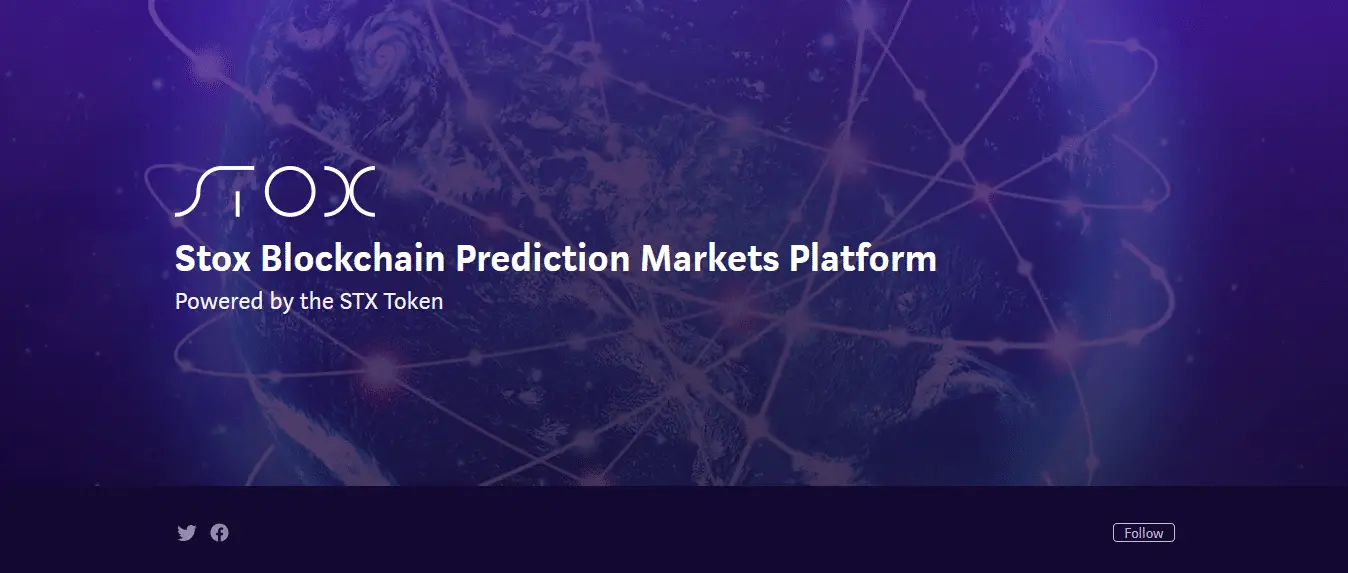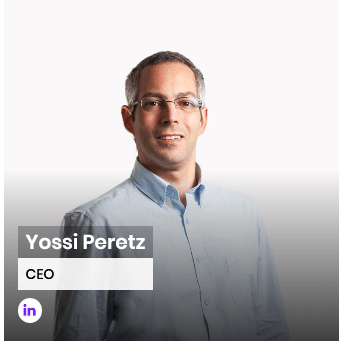Stox (STX) is a blockchain prediction market built on the Ethereum platform. It offers participants the ability to predict the outcomes of events in almost any imaginable category. Harnessing the power of the “wisdom of the crowd” combined with individual intuition, participants can make predictions on events in real-time. Not to be confused with Stacks (also STX), developers on STOX can also build new markets, trade with their peers, and make profits on the platform.
Stox was created and designed by online industry veterans from Invest.com which has been in operation since 2014. The platform targets mainstream audiences by providing a venue where they can find refuge from traditional financial instruments. At the same time, they can leverage their knowledge in several fields to potentially make a profit from their predictions.
The platform will serve several categories ranging from sports, finance, politics, and election results to events such as celebrity marriages or the weather. This well-rounded provision will accommodate the diversified interests of users thereby, increasing overall engagement. Stox’s platform encourages thought leaders and providers to join the network and drive traffic to the network.
In this Stox guide, we’ll take a look at:
- How does Stox work?
- The Stox token
- The Stox app
- Stox team and progress
- Trading
- Where to buy STX
- Where to store STX
- Conclusion
- Additional Stox resources
How Does Stox Work?
The Stox platform comprises three separate participants.
- The providers.
- The operators.
- The users.
Providers
Providers are existing companies that are encouraged to join the Stox network with the incentive of capitalizing on their existing customer base. These providers will develop the Stox app based on the open-source implementation provided by Stox. They have the choice to customize the app to create a user experience that’s according to their best practices.
Apart from that, they also provide users with access to the network through the original Stox app. They may release a branded version of the app according to the reference implementation provided by Stox. By promoting the app to users, the providers get to bring traffic to the Stox network. In return, the providers get financial gain.
The Operators
Operators create events and upon time resolve the real-life world outcome. After creating an event, operators determine the participation fee of the event. Any individual, organization, or entity within the Stox network can become an operator. Operators also act as centralized reputable oracles and provide the collaterals and market reserves needed to run an event.
The Users
There are two ways that users can participate in the network. They can either create events, or they can participate in them. There are different providers on the platform who are expected to focus on different niches of events. Users participate in prediction events they feel a strong affinity towards. Once a user participates in an event, they buy shares of the outcome payout.
If the event resolves to the predicted outcome, the user may collect his share of the payout according to the number of shares they have. If the event resolves to a different outcome, shares of the losing outcome are worth zero, and any token placed on them is lost. The price of the outcome shares fluctuates as the event progresses and more investments are made. The price gets derived from a variant of the LMSR market maker algorithm that’s coded into the event participation smart contract.
The Stox Token
The STX token is an integral part of the Stox platform and a driver for its economy. Almost all the activities that take place on the platform are STX-driven. They include:
- In order for a user to participate in any prediction market running on the Stox network, they must purchase STX. Profits from successful predictions are collected in STX.
- Fees charged for participating in event predictions and investing in event outcomes are collected in STX. These fees are what represent the revenue that creators and market makers receive.
- As syndication fees for promoting events between apps of different providers in the Stox ecosystem.
- Operators are required to hold a certain amount of STX as collateral for publishing certain events for users. Providers are also required to purchase STX to participate in the Stox market.
- The operators also need to hold a reserve of STX to act as a counterparty for investments made by users on specific outcomes during the event.
The STX token will be implemented as a smart token which will utilize the Bancor protocol to maintain liquidity. The properties of this token include:
- Anyone will be able to purchase or sell STX at any time without the risk of not having a counterparty and at a predetermined cost.
- The total amount of STX in circulation can vary dynamically as the market maker creates or removes STX.
- The value of the STX token will be backed up by its BNT reserve. This will assure holders of STX that it has intrinsic value.
- BNT is an Ethereum-based smart token making the conversion process to and from ETH a simple task.
The Stox App
Stox will also create a client for the platform in the form of a fully operational Stox app. The Stox app will provide a fully functional P2P prediction market platform. Users will be able to utilize the app to place STX on event outcomes. The app will also provide users with on-chain access to Stox smart contracts, content, listings, and metadata from decentralized cloud storage.
The app is entirely peer-to-peer, it doesn’t rely on any centralized points of failure. The company intends to place a pre-built version of the app for download in several public locations on the internet. For instance on BitTorrent. They will place a PGP signature of the app on their official website for users to verify that the binary isn’t tampered with.
Once a user downloads the app successfully, they’ll be able to run the application locally on their computers. Future versions of the app will have a mobile version that will run natively on iOS and Android devices. There will be provision for a web-based version that will run inside a web browser without requiring local installation. Once in the market, the app will run on the following platforms:
- Android.
- Linux.
- Mac.
- Windows.
Stox Team and Progress
The Stox team consists of 25 member specialists. 21 of the members represent the core team while the remaining four are reinforcements. Notable names on the team include Yossi Peretz who is Stox’s CEO, Amit Maor the CTO, and Niv Abramovich who is the CMO. Other members of the team include a mixture of managers, software designers, blockchain developers, architects, and lawyers.
As stated earlier, the team has a reinforcement team of about four members. On this team are a number of blockchain architects from CoinTree. They possess a sizable team of board members and advisors. They include Ophir Gertner co-founder of Invest.com and Stox, Uriel Peled CEO of CoinTree, Eyal Herzog Bancor co-founder, among others.
Its main competitors are Augur and Gnosis as they both paved the way for blockchain-based solutions in this field. However, unlike Augur and Gnosis, Stox offers a single token economy. It also utilizes the Bancor protocol to achieve unlimited liquidity and targets growth via providers. The team has past experience in regulated markets, unlike Augur and Gnosis who are new market entrants.
Stox’s development roadmap includes the stages detailed below. They include:
- The Stox platform development.
- Stox App development.
- Launch with Invest.com customer network.
- Development of an ecosystem member SDK.
- Growing the Stox ecosystem.
To meet their vision, Stox has partnered up with key players in the industry. These partners include Sirin Labs, Bancor, ICO Alert, Jaxx, AmaZix, Hyperchain Capital, among others.
STOX Trading
Stox conducted its ICO on 2nd August 2017 with the aim of raising $30 million in about two weeks. However, the ICO lasted for about two days as they achieved their $30 million target. They even surpassed the target by $3 million to raise an astounding $33 million. Right before the ICO, Floyd Mayweather was promoting the ICO on Instagram before it went live.
During the ICO, the STX token went for a steady price of about US $1.21. The STX token price continued to rise well above the $1 mark and hit a high of $2.74 on August 25th. The price, however, dipped below the $1 mark on September 8th, 2017.
The token’s value continued to plummet to under $0.01, currently trading at $0.0028.
As of January 2017, the price of STX rose above the $1 mark but struggled to maintain. During the end of the month, the token took a price dip again below the $1 threshold. Since then, STX price hasn’t gone through any radical change. The price has oscillated between $0.2 to $0.8 with no major price shifts. The total supply of STX tokens is 58,030,638.
Where to Buy STX
Information on the Stox website reveals that you can buy and exchange tokens on several exchange platforms. They include HitBTC, Quoine, EtherDelta, Liqui, Bancor, Coinexchange.io, Gate.io, Cex.com, and Novaexchange.
Where to Store STX
There are many detailed instructions on how to open an Ethereum wallet. We suggest that you start at MyEtherWallet. It’s simple, easy to use, and registering on it is a simple process. Any other Ethereum-based wallet is still useful since the STX is an ERC-20 token.
Once you acquire an Ethereum wallet, you will connect it to your Stox wallet or account where you can withdraw any STX earnings to you. You do this by entering your personal wallet details into the Stox platform to generate a smart contract wallet in the system. When both wallets are in sync, you can distribute STX funds to your personal Ethereum wallet.
You can withdraw your funds from your Stox wallet/account if you are not participating in an active prediction event.
Final Thoughts: STOX and Prediction Markets
The development of blockchain prediction markets is still in its infancy stages. Nevertheless, Stox happens to be one of the few innovations in place alongside Augur and Gnosis.
Stox has recognized that there is a gap in the market between prediction markets and users. It bridges this gap by combining prediction markets with the power of blockchain technology to create a uniquely tailored product for the market. This platform enables the creation of events in form of stocks where participants can trade on the outcome of the event. Users on the platform can buy and sell outcome shares based on what they find as the probability at any time.
Blockchain-based prediction markets are disruptive economic tools that are yet to penetrate markets due to excessive regulations. They operate similarly to financial markets by assigning a trade price to a belief about the future. Large institutions and companies such as Google, use them to conduct internal product development outcomes. Through decentralization and increased popularity, prediction markets can become popular instruments with traders.
Additional Stox Resources
The post What is Stox? (STX) | A Beginner’s Guide appeared first on CoinCentral.





















